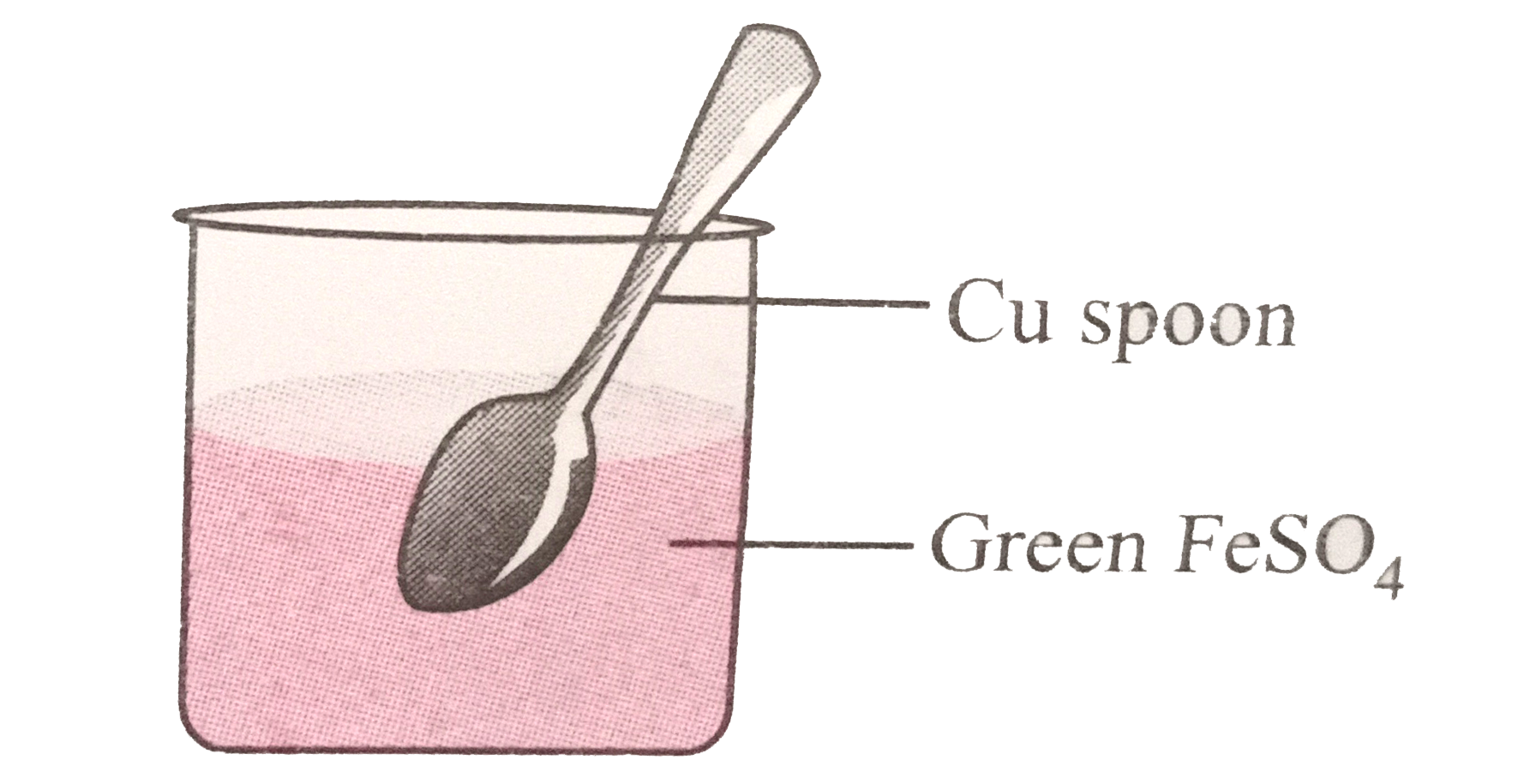If a spoon of copper metal is placed in a solution of ferrous sulphate .
Cu will precipitate out
iron will precipitate
Cu and Fe will precipitate
no reaction will take place
The correct Answer is:D
To solve the problem of what happens when a spoon of copper metal is placed in a solution of ferrous sulfate, we can follow these steps:
Step 1: Identify the reactants and their oxidation states
- The reactants are copper (Cu) and ferrous sulfate (FeSO₄).
- In FeSO₄, iron (Fe) has an oxidation state of +2, while copper (Cu) in its metallic form has an oxidation state of 0.
Step 2: Determine the possible reactions
- When copper is placed in the ferrous sulfate solution, we can hypothesize that a reaction might occur where copper is oxidized and iron is reduced:
- Cu (s) → Cu²⁺ (aq) + 2e⁻ (oxidation)
- Fe²⁺ (aq) + 2e⁻ → Fe (s) (reduction)
Step 3: Check the standard reduction potentials
- The standard reduction potential for Cu²⁺/Cu is +0.34 V.
- The standard reduction potential for Fe²⁺/Fe is -0.44 V.
Step 4: Calculate the cell potential (E°cell)
- The cell potential can be calculated using the formula:
E°cell=E°cathode−E°anode
- Here, the cathode is where reduction occurs (Fe²⁺ to Fe) and the anode is where oxidation occurs (Cu to Cu²⁺).
- Therefore:
E°cell=(−0.44V)−(+0.34V)=−0.78V
Step 5: Analyze the cell potential
- Since the calculated E°cell is negative (-0.78 V), it indicates that the reaction is not feasible under standard conditions.
Conclusion
- Therefore, when a spoon of copper metal is placed in a solution of ferrous sulfate, no reaction will take place.
---
- The reactants are copper (Cu) and ferrous sulfate (FeSO₄).
- In FeSO₄, iron (Fe) has an oxidation state of +2, while copper (Cu) in its metallic form has an oxidation state of 0.
- When copper is placed in the ferrous sulfate solution, we can hypothesize that a reaction might occur where copper is oxidized and iron is reduced:
- Cu (s) → Cu²⁺ (aq) + 2e⁻ (oxidation)
- Fe²⁺ (aq) + 2e⁻ → Fe (s) (reduction)
- The standard reduction potential for Cu²⁺/Cu is +0.34 V.
- The standard reduction potential for Fe²⁺/Fe is -0.44 V.
- The cell potential can be calculated using the formula:
E°cell=E°cathode−E°anode
- Here, the cathode is where reduction occurs (Fe²⁺ to Fe) and the anode is where oxidation occurs (Cu to Cu²⁺).
- Therefore:
E°cell=(−0.44V)−(+0.34V)=−0.78V
- Since the calculated E°cell is negative (-0.78 V), it indicates that the reaction is not feasible under standard conditions.
- Therefore, when a spoon of copper metal is placed in a solution of ferrous sulfate, no reaction will take place.
Topper's Solved these Questions
- BOOK - ALLENCHAPTER - ELECTROCHEMISTRYEXERCISE - EXERCISE-0235videos
ELECTROCHEMISTRY
- BOOK - ALLENCHAPTER - ELECTROCHEMISTRYEXERCISE - EXERCISE-0324videos
ELECTROCHEMISTRY
- BOOK - ALLENCHAPTER - ELECTROCHEMISTRYEXERCISE - INTEGER TYPE18videos
ELECTROCHEMISTRY
- BOOK - ALLENCHAPTER - CHEMISTRY AT A GLANCEEXERCISE - ORGANIC CHEMISTRY472videos
CHEMISTRY AT A GLANCE
- BOOK - ALLENCHAPTER - HYDROCARBONEXERCISE - MCQ15videos
HYDROCARBON
Similar Questions
If a spoon of copper metal is placed in a solution of FeSO4, what will be the correct observation ?
 (A)Copper is dissolved in
F
e
S
O
4
to give brown deposit.
(B)No reaction takes place.
(C)Iron is deposited on copper spoon.
(D)Both copper and iron are precipitatedView Solution
(A)Copper is dissolved in
F
e
S
O
4
to give brown deposit.
(B)No reaction takes place.
(C)Iron is deposited on copper spoon.
(D)Both copper and iron are precipitatedView SolutionIron is _______ copper in the electrochemical series and hence displaces _____ from a solution of copper sulphate.
View SolutionWrite down what happens when iron, copper and magnesium metals are added to an aqueous solution of Zinc sulphate ?
View SolutionState one relevant observation for the following reaction :
Action of Sodium hydroxide solution on ferrous sulphate solution.View SolutionFind the number of electrons involved in the electro-deposition of 63.5 g of copper from a solution of copper sulphate is:
View SolutionChoose solvent solute in the following cases
(i) Brine solution
(ii) Crystalline copper sulphate
(iii) Aq. Solution of copper sulphateView SolutionChoose solvent solute in the following cases
(i) Brine solution
(ii) Crystalline copper sulphate
(iii) Aq. Solution of copper sulphateView SolutionFehling solution A consist of an aqueous solution of copper sulphate while Fehling solution B consists of an alkaline solution of ______.
View SolutionThe position of some metals in the electrochemical series in dectreasing electropositeve character is given as Mg>Al>Zn>Cu>Ag. What will happen if a copper spoon is used to stir a solution of aluminimum nitrate ?
View SolutionThe position of some metals in the electrochemical series in dectreasing electropositeve character is given as Mg>Al>Zn>Cu>Ag. What will happen if a copper spoon is used to stir a solution of aluminimum nitrate ?
View Solution
